1 Introduction
Thermoelectric effect involves the conversion between electrical energy and thermal energy. There are three main types to this effect: the Seebeck effect, which converts thermal energy into electrical energy, the Peltier effect, which converts electrical energy into thermal energy, and the Thomson effect. The thermoelectric effect is evaluated through the dimensionless value, thermoelectric figure of merit (ZT). The formula is as follows [1]:
where S, Žā, K, and T represent the Seebeck coefficient, electrical conductivity, thermal conductivity, and temperature, respectively. The conversion efficiency (╬Ę) of a thermoelectric generator (TEG) is a fraction of the Carnot efficiency, which is the maximum efficiency of the reversible cycle, and is given by the formula [2]:
where TH and TC are the temperatures of the hot and cold sides, respectively. The term (TH ŌĆō TC)/TH at the forefront of ZT represents the Carnot efficiency. From equations (1) and (2), we can see that we need to maximize the value of ZT to enhance the conversion efficiency of TEG.
As industries become more sophisticated, real-time monitoring technology is essential to prevent fatigue, destruction, and environmental damage to various structures [3ŌĆō5]. In particular, real-time monitoring is necessary for structures and environments that have limited human access, such as nuclear power plants and volcanoes [6ŌĆō8]. Mona et al. investigated the feasibility of utilizing geothermal energy as a renewable energy source in a hot spring in Thailand through a power generation system for IoT monitoring utilizing thermoelectric generator (TEG) modules and geothermal heat sources to create optimal system operating conditions [6]. Catalan et al. proposed a volcano monitoring station that utilizes IoT technology via thermoelectric generators to operate maintenance-free for more than eight months of operation [7]. Chen et al. reported an experimental study of a thermoelectric energy harvesting system designed for integration into a nuclear power plant that can generate enough power to operate in a radiation-rich environment and to operate wireless sensors to increase plant safety [8].
Meanwhile, the necessity of improved battery efficiency is growing as the demand and supply of wearable devices are increasing. Recently, numerous studies have been performed in the direction of not only improving the capacity and performance of batteries but also exploring technologies for self-generation [9ŌĆō11]. Ren et al. reported a self-healing and recyclable TEG system with excellent stretchability and thermoelectric performance. The system achieved a power density of 1 V/cm2 at a temperature gradient of 95 K [9]. Hong et al. demonstrated a device capable of thermoelectric power generation with heat from human body and cooling with TEGs fabricated by machining the surface of a commercial TEG [10]. Kim et al. presented the implementation of a honeycomb-shaped energy harvester and a modeling method for the electrode and hole regions, and then reported a successful study of thermoelectric power generation from body heat with a harvester fabricated under optimal conditions [11].
In addition, the COVID-19 pandemic that broke out in 2020 has increased the demand for technology for bio/human body monitoring using wearable devices. In response, numerous research on self-powered sensors have been steadily progressing through TEG [12ŌĆō14]. Sani-Villa et al. proposed a thermoelectric generator wearable device that can detect fever symptoms at an early stage as a solution to prevent the spread of disease [12]. Bai et al. fabricated a gel electrolyte-based thermogalvanic generator, and a gel patch with high specific heat capacity in addition to thermoelectric performance can effectively reduce the body temperature of fever patients. This research opened new avenues for smart healthcare based on wearable or implantable electronics [13]. Wan et al. fabricated a yarn-based wearable TEG and demonstrated a self-powered wireless motion detector and a glove that can sense temperature [14].
Finally, as AI technology advances significantly, the foundation for proactive monitoring is expected to be established through the integration of AI technology with IoT technology based on big data in the future [15,16]. Therefore, this paper aims to introduce the application of TEG in structural and biomedical monitoring systems, as it can be beneficially utilized across various industries. Through this paper, we seek to provide an overview of TEG and present the current trends in this cutting-edge technology. First, the types of thermoelectric generators are introduced, and the current research trends are categorized into structural/environmental monitoring and biomonitoring systems.
2 Thermoelectric Generators (TEGs)
2.1 Inorganic TEGs
The Seebeck effect was discovered in the 1800s, but it was only after more than a century that proper research progressed, which is related to the equation (1) mentioned above. First of all, there is no substance in nature that has a high electrical conductivity and a low thermal conductivity. Metals have high electrical conductivity, but also high thermal conductivity, and non-metals have low thermal conductivity and low electrical conductivity. Therefore, no significant achievements were made until the advent of semiconductors. Currently, the types of thermoelectric materials used in TEGs can be divided into inorganic thermoelectric generators and organic thermoelectric generators.
Inorganic TEGs can be categorized into rigid-TEGs and flexible-TEGs based on their flexibility. Rigid-TEGs are literally characterized by a flat surface and include commercial Peltier devices. Xia et al. proposed an energy harvesting system through body heat using a commercial rigid-TEG. With an input voltage of 104 mV and a transfer cycle of 65 s, the TEG applied to the human body was able to harvest 302.7 ╬╝W of power from a supercapacitor. The conversion efficiency was 26.5%, and 89.7% of the power harvested was stored in the storage component. When the input voltage reached 180 mV, 1,620 ╬╝W of power was produced by the TEG and 336.9 ╬╝W of power could be harvested into a rechargeable battery [17]. Although there are research examples like this, the rigid-TEGŌĆÖs outer surface makes it easier to utilize on flat surfaces, so it is mainly used for structural and environmental monitoring [6ŌĆō8,18].
On the other hand, parts of the human body such as the arms or wrists have curves, making rigid-TEGs with flat surfaces less flexible. Therefore, flexible-TEGs are commonly used in wearable devices. Ren et al. fabricated a flexible-TEG by depositing thin-film thermoelectric materials on a polyimide film via a thermal evaporator. These TEGs achieved open-circuit voltages as high as 1 V/cm2 at a temperature difference of 95 K and can be reconfigured like Lego blocks, allowing users to customize energy harvesting devices according to thermal and mechanical conditions. This work reported a self-healing and recyclable TEG system with excellent stretchability and thermoelectric performance [9]. Xing et al. prepared a micro-TEG by cutting a bulk material (p-Bi0.5Sb1.5Te3, n-Bi2Te2.7Se0.3) into a cuboidal shape, pre-plating nickel (~5 ╬╝m) and gold (~100 nm) films on its upper and lower surfaces and welding a sandwich structure composed of an ŌĆ£AlN substrate/TE leg/AlNŌĆØ substrate with AuSn solder (Fig. 1(b)). Fig. 1(a) shows the TEG worn on the arm and its thermal resistance schematic. It is found that the actual maximum power output of the TEG was about 0.2 mW and the actual maximum power output of the TEG module was about 1.602 mW at the hot end temperature Th = 33┬░C and the cold end temperature Tc = 30┬░C, which are in good agreement with the simulated values. This study provides great convenience for the research and development of wearable thermoelectric modules and provides a new, environmentally friendly, and efficient power solution for wearable devices [19].
Hong et al. fabricated a rigid-TEG into a flexible-TEG by replacing the surface of a commercial TEG with Ecoflex/AIN. With a design consisting of a double elastomer layer and a TE leg with a high ZT, they demonstrated a wearable TEG that provides cooling effect more than 10┬░C with a high coefficient of performance (COP > 1.5) for a long period of time with high flexibility. The device achieved a maximum power generation of ~4.5 ╬╝W/cm2 and an open-circuit voltage of ~74.5 mV on human skin under room temperature (Tair = 22┬░C) conditions of natural convection. Power generation increased up to ~10.7 ╬╝W/cm2 under light forced convection (walking) and up to ~25.1 ╬╝W/cm2 under cold conditions (sitting, Tair = 10┬░C). Temperature control based on these devices could enable a shift from centralized to personalized cooling, with the benefits of significantly reducing energy consumption and improving human comfort [10].
2.2 Organic TEGs
Inorganic-based generators such as bismuth telluride, which is currently the best performing thermoelectric material have commercial applications such as thermoelectric refrigerators, but they are rare, expensive, brittle, difficult to process, and most importantly, toxic. On the other hand, organic materials that can offset the disadvantages of inorganic materials are flexible and easy to process, but their electrical performance is significantly lower than that of inorganic materials. Therefore, to compensate for these shortcomings, researchers have synthesized conductive polymer composites with carbon nanotubes (CNTs) [20ŌĆō24].
Yu et al. prepared polymer composites and measured their thermoelectric properties as a function of CNT concentration at room temperature. The study shows that the electrical conductivity can be dramatically increased by creating CNT networks in the composites, while the thermal conductivity and thermoelectric power are relatively insensitive to the filler concentration. The composite with a CNT concentration of 20 wt% exhibits an electrical conductivity of 4,800 S/m at room temperature, a thermal conductivity of 0.34 W/m┬ĘK, and a thermoelectric figure of merit (ZT) greater than 0.006 [20]. The thermoelectric properties of CNT-filled polymer composites can be enhanced by modifying the junctions between CNTs using poly (3,4-ethylenedioxythiophene) poly (styrene sulfonate) (PEDOT:PSS), and high electrical conductivity (up to 40,000 S/m) can be obtained without significantly changing the thermopower (or Seebeck coefficient). This is because the PEDOT:PSS particles decorate the CNT surface and electrically connect the junctions between CNTs [21,22]. On the other hand, the heat transfer remains comparable to typical polymeric materials due to the different bonding and vibrational spectra of CNTs and PEDOT:PSS. In this study, the highest thermoelectric figure of merit (ZT) is estimated to be 0.02 at room temperature, which is at least one order of magnitude higher than most polymers and higher than bulk Si [21].
Since TEG is composed of p-n couples, various studies have been conducted on n-type organic materials. In particular, there have been studies involving the conversion of p-type CNTs, which are oxidized in air, into n-type CNTs using chemicals and confirmed their air stability [23,24]. Ryu et al. treated CNTs with Polyethyleneimine (PEI), and the oxygen in the air donated electrons to the CNTs to convert p-type CNTs to n-type. A large negative Seebeck Coefficient of ŌłÆ58╬╝V/K was obtained and maintained for at least several days [23]. Freeman et al. functionalized CNTs with PEI and composited them with polyvinyl acetate (PVAc), resulting in stable n-type properties in air with electrical conductivity of ~1,500 S/m and thermopower of ~2,100 mV/K [24].
The previous research examples were about film-type organic TEGs. In addition to the film type there is also a bulk type of organic TEGs [25ŌĆō29]. In the following sections, the research examples of organic TEGs will be described in detail, starting with film and then bulk types. Table 1 summarize the thermoelectric (TE) performance of organic TE composites reported in the literature. Ref. 31,33 present for film type composites, and 25ŌĆō28, 35 for bulk type.
2.2.1 Film Type TEGs
Zhou et al. fabricated a leaf-inspired flexible thermoelectric generator (leaf-TEG) that makes full use of temperature difference by vertically aligning a free standing PEDOT:PSS film fabricated via drop-casting and a commercial constantan film. In an air duct (substrate: 36┬░C, air: 6┬░C, air flow: 1 m/s), a 10-leaf-TEG shows a temperature difference utilization ratio (ŽĢth) of 73% per leaf and a maximum power output of 0.38 ╬╝W, while a 100-leaf-TEG (60 cm2) at room temperature generates 11 ╬╝W of power on its arm. The TEGs have been validated for flexibility and durability by bending and brushing over 1,000 times [30]. To improve the long-term stability of the n-type operation of CNTs in air and water, Hata et al. used cationic surfactants such as Gemini surfactant octylene-1,8-bis (dimethyldodecylammonium bromide) (12-8-12) to stabilize the coated-CNTs, which remained n-doped for more than 28 days after air and water exposure in their experiments (Fig. 2). Fig. 2(a) presents a schematic of the experimental process of the surfactant/CNT film, and Figs. 2(b)ŌĆō2(g) are SEM images of the samples, which show that the CNT-surfactant film has few nanotube defects and crystallinity after fil formation. As shown in Table 1, the singe-wall carbon nanotube (SWCNT) 0.06 wt%/benzyldodecyldimethylammonium bromide (BDDAB) composite has the highest power factor of 2.25 ├Ś 102. TEGs with 10 p-n units of 12-8-12/CNT (n-type) and dodecylbenzene sulfonate/CNT (p-type) layers were fabricated, and the water stability of the TEG module was evaluated by immersing it in water for 40 days without the use of a sealant. Even after this period, the initial maximum output of 16.1 ╬╝W (╬öT = 75 K) was maintained, demonstrating the water stability of the TEG module [31].
Kim et al. fabricated a honeycomb-shaped TEG using PVDF, and by performing theoretical calculations to analyze the correlation between hole and electrode area, they found that the honeycomb-shaped pyroelectric energy harvester (H-PEH) with an electrode and hole area ratio of 1: 1.5 has the best performance. The maximum power output of the optimized H-PEH was 0.154╬╝W at a temperature difference of 1.5 K, which is up to 30.4% larger than the conventional (non-honeycomb-shaped) PEH. It was also 200% and 224% larger than the conventional TEG depending on the wind speed (2 m/s and 4 m/s), respectively [11]. Wang et al. prepared PEDOT: PSS films by spin coating and a set of ITO films by high-frequency magnetron sputtering in a gas mixture to fabricate film-type TEGs. The dense p-type PEDOT:PSS and n-type ITO thin films exhibit ZT values of 0.30 and 0.29 and thermal conductivities of 0.22 and 0.32 W/m┬ĘK at 450 K, respectively. In Fig. 3, a flexible TEG module with a high transmittance of more than 81% in the visible wavelength range of 400ŌĆō800 nm was fabricated using 10 pairs of p-n legs, and an open-circuit voltage of 31 mV, a maximum power of 14.3 nW, and a high-power density of 22.2 W/m2 at a temperature gradient of 80 K were observed [32].
Hong et al. fabricated high-performance CNT/P3HT nanocomposite films and flexible CNT/P3HT TEGs by spray-printing. The Seebeck coefficient, electrical conductivity, and power factor of the nanocomposite films were 97 ┬▒ 11 ╬╝V/K, 345 ┬▒ 88 S/cm, and 325 ┬▒ 101 ╬╝W/m-K2 at room temperature, respectively. Particularly, it can be seen from Table 1 that the power factor value of the film produced by spray-printing is improved by about 41% compared to that of drop-casting [33]. In, Figs. 4(a), 4(b), Jung et al. fabricated a highly stretchable wearable fiber-based TEG using commercial thermoelectric inks. The optimized TEG generates a thermoelectric voltage output of 1.1 mV at a temperature difference of 100 K through the combination of PEDOT:PSS and AgNPs inks and shows high durability up to 800 cycles at 20% deformation. The knitted fiber substrate also exhibits temperature sensing properties along the stretch direction [34].
2.2.2 Bulk Type TEGs
Lund et al. produced a fiber TEG by embroidering PEDOT:PSS-coated silk threads onto wool fabric, as shown in Fig. 4(c). The TEG can produce 0.2 μW of power at ΔT = 30 K and 1.2 μW of power at ΔT = 65 K [35]. Kim et al. fabricated porous TE sponges by coating SWCNT ink on sponges, then fabricated stretchable and elastic TEGs with high durability, and measured and calculated various TE properties while applying compression and pressure. When increasing the compressive strain from 0 to 80% through controlling in pore size and density, the TE properties of the porous TE sponge such as electrical conductivity, power factor, and ZT value were enhanced. In addition, the maximum output power of the TE sponge generator with 8 p-n pairs increased significantly from 0.17 μW to 2.09 μW at a temperature difference of 55 K from 0 to 80% compressive strain [25].
Zhang et al. reported a multifunctional superelastic graphene-based thermoelectric (TE) sponge for wearable electronics and thermal management. The sponge had a high Seebeck coefficient of 49.2 ╬╝V/K and a large compressive strain of 98%. After 10,000 cyclic compressions at 30% strain, the sponge exhibited good mechanical and TE stability. The device produces an output power of 0.017 ╬╝W at a temperature difference of 16 K. In addition, placing a 4 ├Ś 4 array TE device on the surface of a normally operating central processing unit (CPU) could generate a stable voltage and reduce the CPU temperature by 8 K, offering the possibility of realizing power generation and thermal management at the same time [26]. Thongkham et al. proposed a flexible and lightweight TEG coated with a PEDOT:PSS/SDS solution on melamine foam using a simple immersion drying technique. According to Table 1, ZT of the thermoelectric foam is about 0.006ŌĆō0.007. It also had an output voltage of 1.1 mV at ╬öT = 40 K. This study can help in the design and optimization of hybrid TEGs that can act as both insulators and generators [27].
Kang et al. used a simple and fast solvent evaporation process to produce 3D CNT/PDMS foams with both high thermoelectric (TE) and excellent mechanical performance and used them to fabricate highly flexible and durable TEGs. The numerous pores and interfaces of the CNT/PDMS foam, with a porosity exceeding 87%, provided an extremely low thermal conductivity of 0.13 W/m-K, and the ZT value of the foam is 6.6 ├Ś 10ŌłÆ3. Furthermore, it demonstrated a practical foam TEG that generates a sustainable output power of 3.1 ╬╝W at 80% compressive strain and 38.2 nW under sustained vibration stress from an automotive engine [28]. Kim et al. introduced a thermoelectric clay made of CNTs and a non-ionic surfactant as a viscous additive for use in skin-adaptive permanent power sources for e-skins. By adjusting the kneading ratio (1: 5) of CNTs and viscous additives, the thermoelectric clay can be reconstituted with an elastic modulus lower than that of human skin, providing high elongation of up to 100% and resilient skin adaptability even after cracking. 5 pairs of n and p-type thermoelectric clays are used to fabricate thermoelectric power patches for skin-adaptive electronic skin, with an output power of up to ~0.35 ╬╝W at a temperature difference of 5 K. The patches were successfully operated under severe folding, twisting, stretching, and puncturing, and their thermoelectric properties retained more than 80% of their initial values after one year [29].
3 Monitoring Systems Powered by TEGs
3.1 Structure/Environment Monitoring Systems
Tables 2 and 3 summarize TEG-powered structure/environment monitoring systems and human body monitoring systems reported in the literature, respectively, which provide information on the output performance of TEGs over a temperature gradient and the sensors used in each system. Mona et al. proposed a power generation system for IoT monitoring utilizing TEG modules and a geothermal heat source, as shown in Fig. 5(a). Twenty series-connected TEG modules are installed in a heat transfer channel immersed in a hot tub, and the IoT system connects temperature, humidity, and SO2 sensors to monitor information from the hot spring and collect data to a cloud backup. Table 2 shows an output voltage of 12 V and an output power of 1.6 W at a temperature difference of 48 K, indicating that the geothermal power system equipped with the TEG module works well as a power source for IoT monitoring, and the IoT module also works stably with the cloud [6]. Catalan et al. utilized IoT technology to design an all-in-one system consisting of a commercial TEG with a high-efficiency heat exchanger and associated electronics. Over an operational period of more than 8 months, the TEG demonstrated robustness and durability by operating without maintenance under various weather conditions. Table 2 illustrates the TEGŌĆÖs endurance, showcasing an average power generation of 0.49 W at a temperature difference of 51.5 K and continuous discharge for over 14 km [7].
Chen et al. reported an experimental study of a thermoelectric energy harvesting system capable of generating enough power to operate wireless sensors for nuclear power plant safety monitoring. In the corresponding study, two experiments were conducted on the thermoelectric energy harvesting system. The first experiment delivered up to 2.25 W of power using two 2.79 cm (1.1ŌĆ│) ├Ś 2.79 cm (1.1ŌĆ│) Bi2Te3 thermoelectric modules at a source temperature close to 250┬░C. To extend the application in the primary loop at higher temperatures, the second experiment design was presented, where one PbTe-Bi2Te3 hybrid TEG module measuring 5.6 cm (2.2ŌĆ│) ├Ś 5.6 cm (2.2ŌĆ│) can provide 3.0 W of power when reaching 340┬░C (Table 2). To estimate the expected lifetime accumulation of one implemented thermoelectric generator, a total dose of 200 kGy┬▒10% (20 M radiation dose) was applied to the first prototype, and the thermoelectric module used in the prototype showed no reduction in voltage output throughout the irradiation. Throughout the experiment, the harvester system witnessed a slight drop in open circuit voltage due to heat pipe degradation from radiation exposure but achieved a baseline radiation survivability level of 102 Gy for unhardened and unshielded electronics [8].
Feng et al. designed and fabricated a film-based TEG on a roll-to-roll fabrication platform to achieve optimized device structure and performance, which can recover waste heat in underground pipeline systems. The proposed fabrication method combines bulk TE devices with flexible printed circuit boards to maximize power output and minimize cost. The power output density of the TEG incorporating 4 pairs of p-n junctions is shown to be 1.26 mW/m2 at a temperature difference of 50 K [36]. Zhang et al. fabricated a novel power supply system with a Frensel lens and cavity structure as shown in Fig. 5(b). When the floating device was irradiated with 896.38W/m2 of sunlight, it generated an output voltage of 381.03 mV and an output power of 8.86 mW through thermoelectric power generation. Using a wind speed of less than 3.3 m/s above the water surface, the deviceŌĆÖs cooling system could be driven, which increased the output power by 10.96 %. This new power supply system is waterproof and can float stably on the water, allowing for monitoring of various wetland environments [18]. Mukaida et al. reported the design and fabrication of gram-scale polymer-based thermoelectric modules fabricated by laminating ultrathin semi-dry PEDOT:PSS films with Ni foil. These devices have a power density of 72 ╬╝W/cm2 at 100┬░C under natural cooling conditions without a heat sink. The devices at 5 g can fully charge a commercial lithium-ion battery (Nichicon SLB03070LR35) in less than 2 days. The fabricated organic thermoelectric devices can be used to power commercial sensors such as acceleration, geomagnetism, temperature, humidity, atmospheric pressure, and illumination in place of CR2032 coin cells. The fabricated devices showed excellent stability for more than two months under continuous operating conditions [37].
Al-Bahrani et al. synthesized polyurethane (PU) resin using different multi wall carbon nanotube (MWCNT) concentrations to construct a self-sensing nanocomposite sensor with high electrical conductivity. As can be seen in Figs. 6(a), 6(b), the MWCNT/PU nanocomposite sensors were placed on a heat sink (i.e., between the fins), then the multimeter simultaneously recorded the resistance change with the thickness of multiple MWCNT/PU sensors. In Fig. 6(c), the low temperature dropped below the ambient temperature and then settled down to a stable state at around 12.5┬░C for more than 3 hours. Fig. 6(d) shows the resistance variation of the sensor at different temperatures and thicknesses when the thermoelectric cooler (TEC) was left on for more than 3 hours, and the resistance of the sensor increased as the TEC temperature decreased, indicating a negative temperature coefficient [38].
3.2 Human Body Monitoring Systems
As shown in Figs. 7(a), 7(b), Yang et al. presented a wearable TEG integrated with an energy management system that can utilize body temperature to power sensors and Bluetooth. It worked consistently even with minimal temperature differences between human skin and the surrounding environment (e.g., 4 K), ensuring reliable data transmission in as little as 1.6 s. In addition, the system can be charged by utilizing body heat under ultra-low voltage conditions (30 mV). This system provides a new pathway for continuous and reliable temperature-humidity monitoring of standalone wearable devices without relying on batteries as shown in Fig. 7(d) [39]. Yuan et al. developed a highly efficient TEG utilizing bismuth telluride particles assembled on a flexible polyimide substrate. With a power density of 3.5 ╬╝W/cm2, 12.3 ╬╝W/g, and a boost output voltage of 2.8 to 3.3 V, the TEG exhibits excellent power performance at body temperature without movement and wind, enabling continuous simultaneous monitoring of temperature, humidity, and human activity [40].
Wang et al. fabricated flexible TEGs by laser engraving technology with surface microstructures. To provide a stable and renewable power source for the pressure sensor, a thermal insulation film with high thermal conductivity was used for heat absorption and a flexible hydrogel was used as a heat sink. Table 3 shows that the TEG has an output power of 7.9 ╬╝W at a temperature difference of 20 K.
In particular, the pressure sensitivity of the self-powered system was independent of the temperature gradient, so it could maintain stable performance under various temperature differences between human skin and the surrounding environment. The self-powered pressure sensing system proposed in this study can continuously monitor human physiological signals and body movements using only skin-attached TEGs without electronic boost circuits [41].
Kim et al. proposed a wearable TEG system integrated with a novel Li-ion battery. The main disadvantage of low thermoelectric output voltage during battery charging is greatly mitigated by a high-performance Li-S battery whose charging voltage is only half that of a Li-ion battery. The TEG can continuously produce up to 378 ╬╝W of power (Table 3) at a temperature difference of 10 K to operate a commercial glucose sensor (64 ╬╝W) and store the rest in a Li-ion battery to provide a stable voltage of 2 V even in situations of fluctuating power supply. This work demonstrates the feasibility of operating a commercial glucose sensor using only body temperature, enabling sustainable operation without interrupting the wearable device or requiring cumbersome battery charging/replacement [42]. Kim et al. proposed an ECG sensing circuit system fabricated on a flexible PCB powered by a wearable TEG using body temperature as an energy source. To enable the TEG to be worn while obtaining a large temperature difference for high power output, they devised a polymer-based flexible heat sink (PHS) composed of a superabsorbent polymer (SAP) and fibers that promote liquid evaporation. The output power density of the TEG with the PHS was over 38 ╬╝W/cm2 in the first 10 minutes and over 13 ╬╝W/cm2 after 22 hours of continuous circuit operation. This power level is high enough to continuously drive a wearable ECG system, including sensors and power management circuitry [43].
Bai et al. fabricated a gel electrolyte-based thermo-galvanic generator using Fe3+/Fe2+ with 10 redox pairs, which provides excellent flexibility as well as moderate thermoelectric performance. Considering the good temperature responsiveness of the gel, a self-powered body temperature monitoring system was built by attaching it to the forehead. A microporous PVDF diaphragm was inserted into the gel to create a thermal barrier between the two halves, effectively improving the Seebeck coefficient by reducing the thermal conductivity. Meanwhile, the gel patch with high specific heat capacity can effectively reduce the body temperature of fever patients [13]. In Figs. 8(a), 8(b), Wan et al. fabricated a fiber-based organic TEG by coating a commercial yarn with PEODT:PSS. The developed material can sense strain (first mode) and temperature (second mode) and can power itself thermoelectrically (third mode), eliminating the need for an external power supply. As shown in Fig. 8(d), the voltage output was measured under different strains, and this voltage remains constant at the same temperature difference for all strains between 0% and 30%. The TEG also exhibited stable thermoelectric behavior that can be utilized for both temperature sensing and self-powering (~0.5 μW for a 10-couple module at ΔT ~95°C). In Fig. 8(c), a variable temperature at one end of the TEG can be detected as a change in voltage, while a constant reference temperature (e.g. room temperature) can be set at the other end of the yarn, causing the TEG to deliver a different voltage accordingly. As a demonstration in Fig. 8(e), a wireless motion detector and proof-of-concept glove that can harvest body energy and sense environmental and object temperature in a self-powered mode were demonstrated [14].
Han et al. prepared TEGs in the form of organic spacer fabrics by large-scale knitting of CNT yarn-based segmental thermal transfer. With an optimal design with good wearability and stability, they demonstrated a high-power density of 51.5 mW/m2 and a high specific power of 173.3 ╬╝W/(g┬ĘK) at ╬öT = 47.5 K, demonstrating the applicability of TEGs in continuously powering body temperature sensors [44].
By fabricating a PVDF film with electrodes on both sides, Xue et al. reported a wearable TEG integrated into a ventilator driven by human respiratory activity and functioning as a self-powered respiration and temperature sensor. It can produce up to 8.31 ╬╝W of output power at a temperature difference of 25 K, which can be utilized to directly drive electronic devices such as liquid crystal displays and light-emitting diodes [45].
4 Conclusion
This review paper introduces the types of TEGs and the factors that determine their performance and summarizes recent research trends in TEG-based systems that can be used for real-time monitoring of structures and the human body. Since TEGs have different performance depending on the type and concentration of thermoelectric materials, it is possible to fabricate TEGs with the desired performance by adjusting the components, conditions, and fabrication methods. In particular, the performance of TEGs utilized in structural/environmental monitoring systems shows that the output power of inorganic TEGs is nearly 17,000 times higher than that of organic TEGs at a similar temperature gradient (Table 2).
As mentioned earlier, inorganic TEGs dominate in structural/environmental monitoring systems due to their high-power consumption. On the other hand, biosensors used for biomonitoring require less power than structural/environmental systems, so they can be powered by organic TEGs with relatively low output power. In addition, organic TEGs are simpler to process than inorganic TEGs, resulting in lower manufacturing costs, and their non-toxicity and flexibility make them excellent for wearable sensing. With the current technology, the power source for biosensors in commercial wearable devices is limited, but if the performance and durability of TEGs can be improved by creating effective internal structures of thermoelectric fillers and efficient production methods in the future, wider applications can be secured. Furthermore, although organic TEGs are easier to process than inorganic ones, they are not yet ready for commercialization, so research into mass-producible technologies is essential.
In conclusion, TEGs will continue to be actively researched as an important factor enabling real-time monitoring of structures/environment and human body. In the future, the integration of AI-based big data systems is expected to be a good solution for increasing the amount of data to be sensed as the performance of the power source improves due to technological advancements. Therefore, research on TEG monitoring systems integrated with AI could make a significant contribution to safety diagnostics and proactive preventive action.



 E-mail
E-mail Print
Print facebook
facebook twitter
twitter Linkedin
Linkedin google+
google+

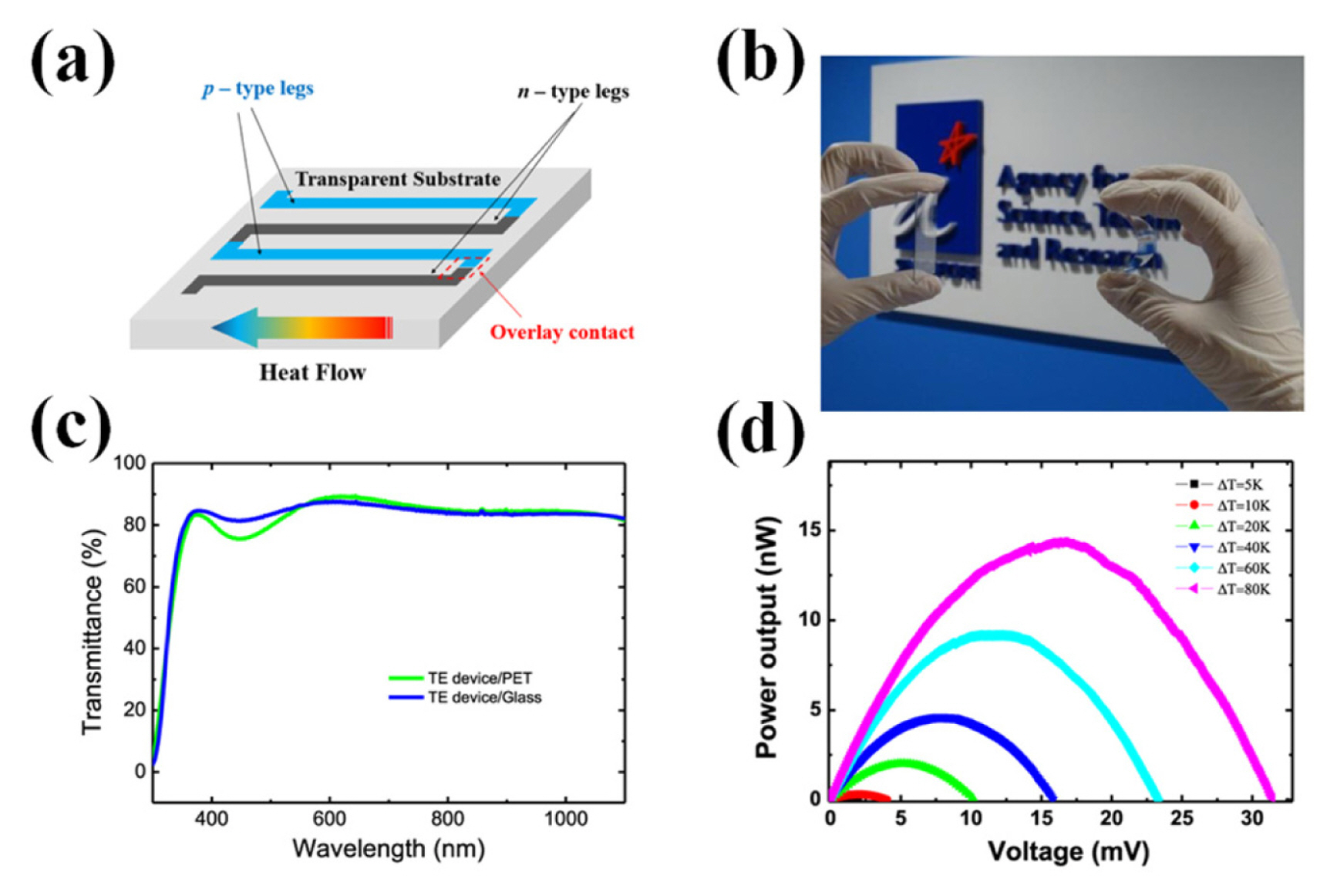

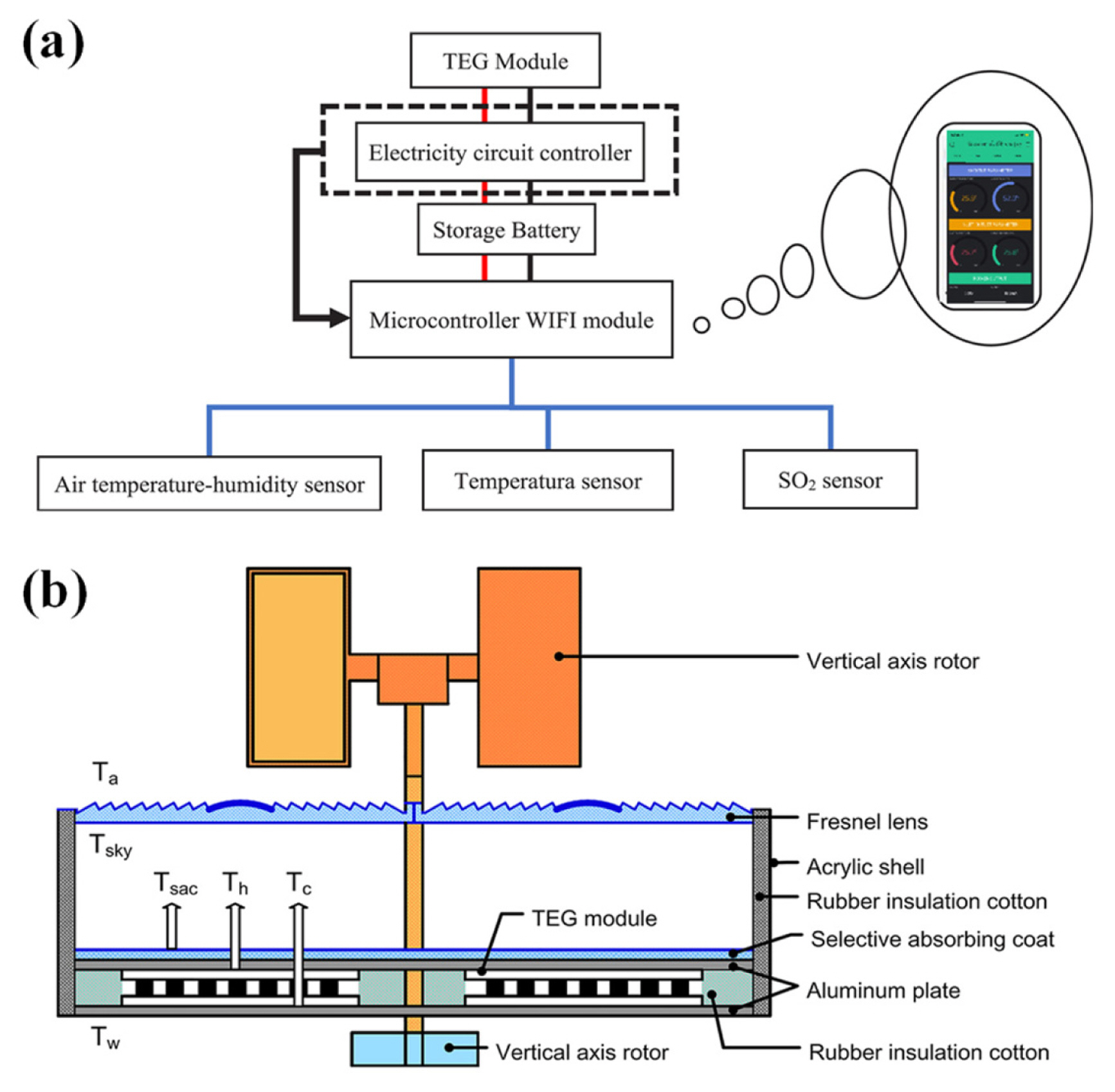
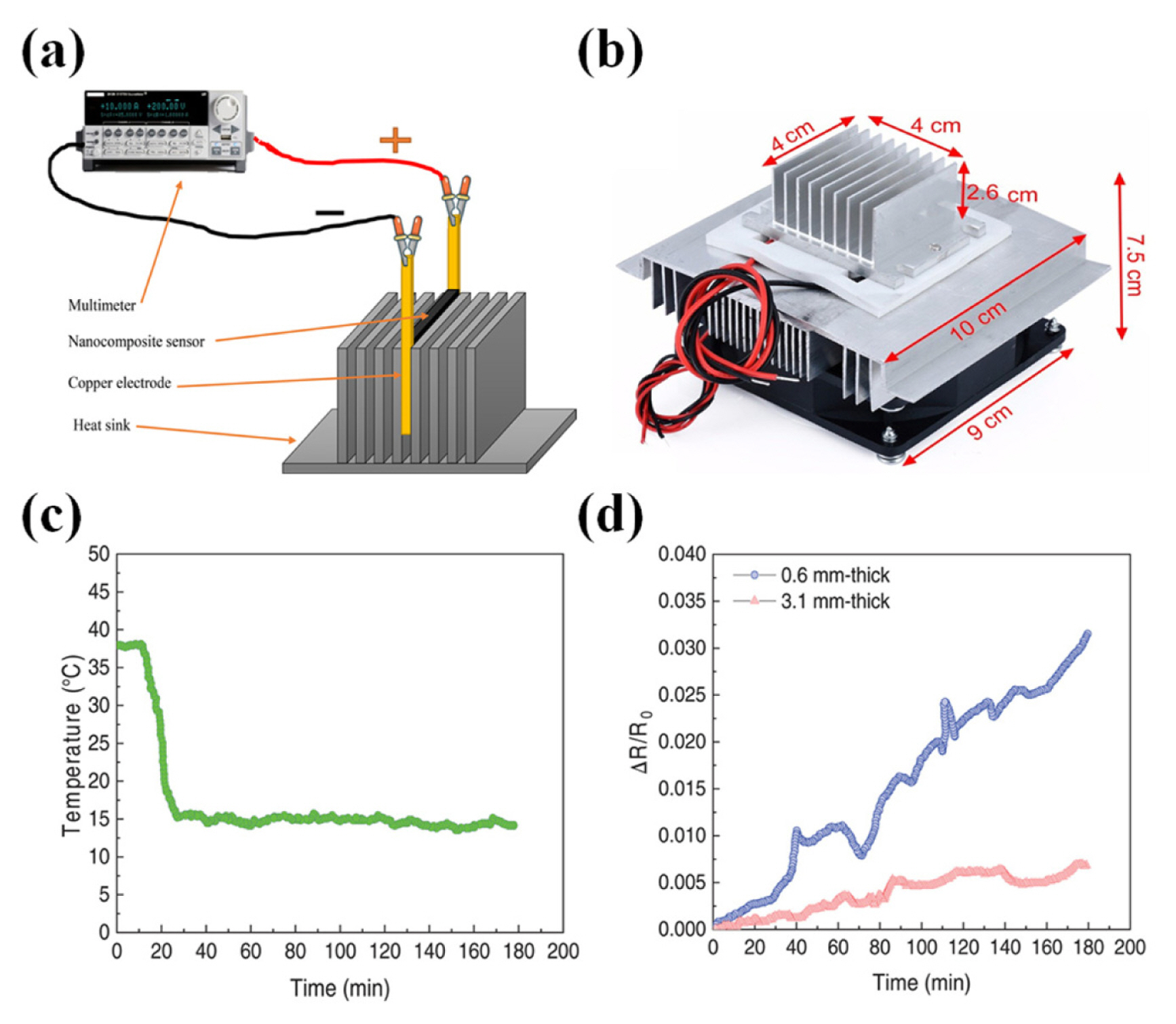
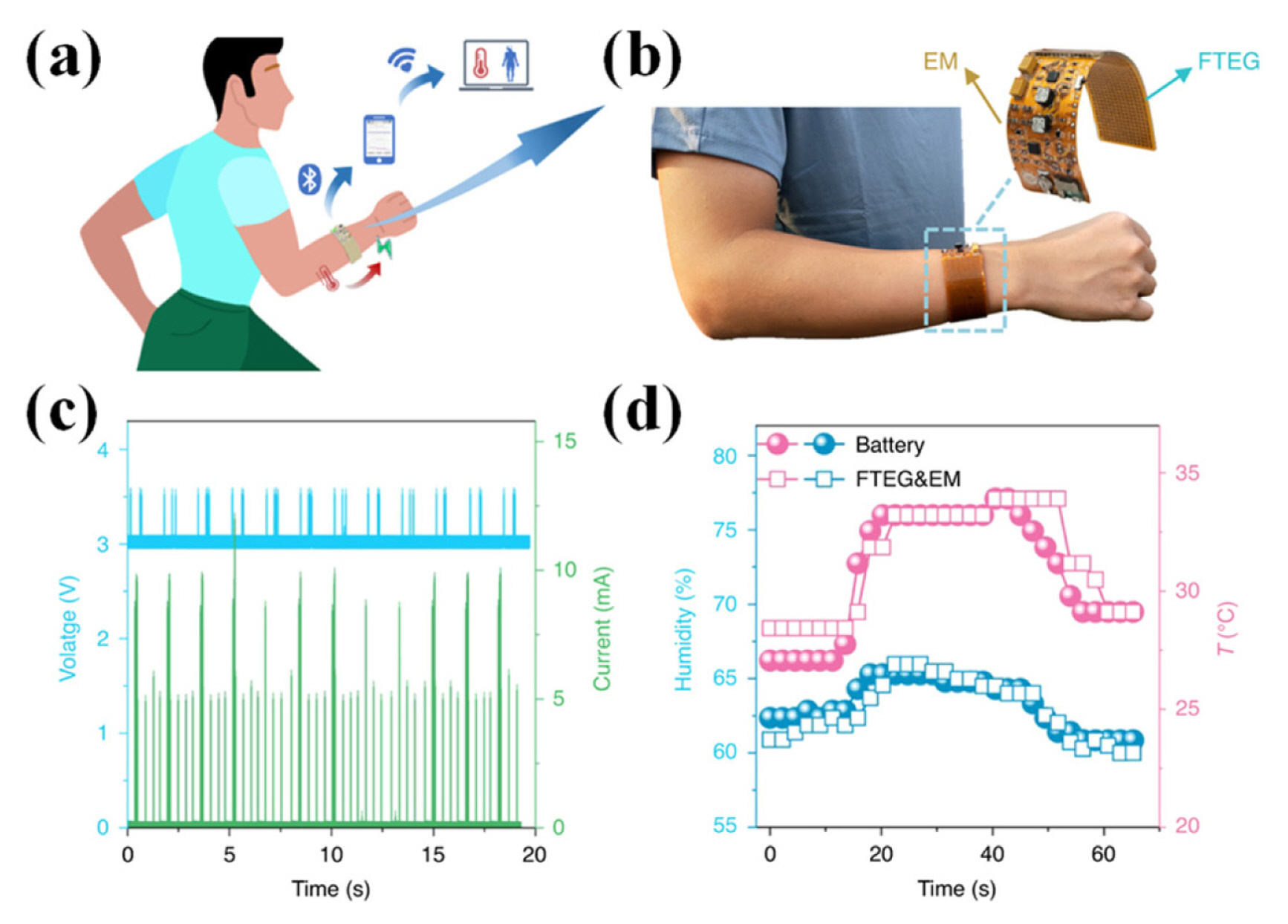
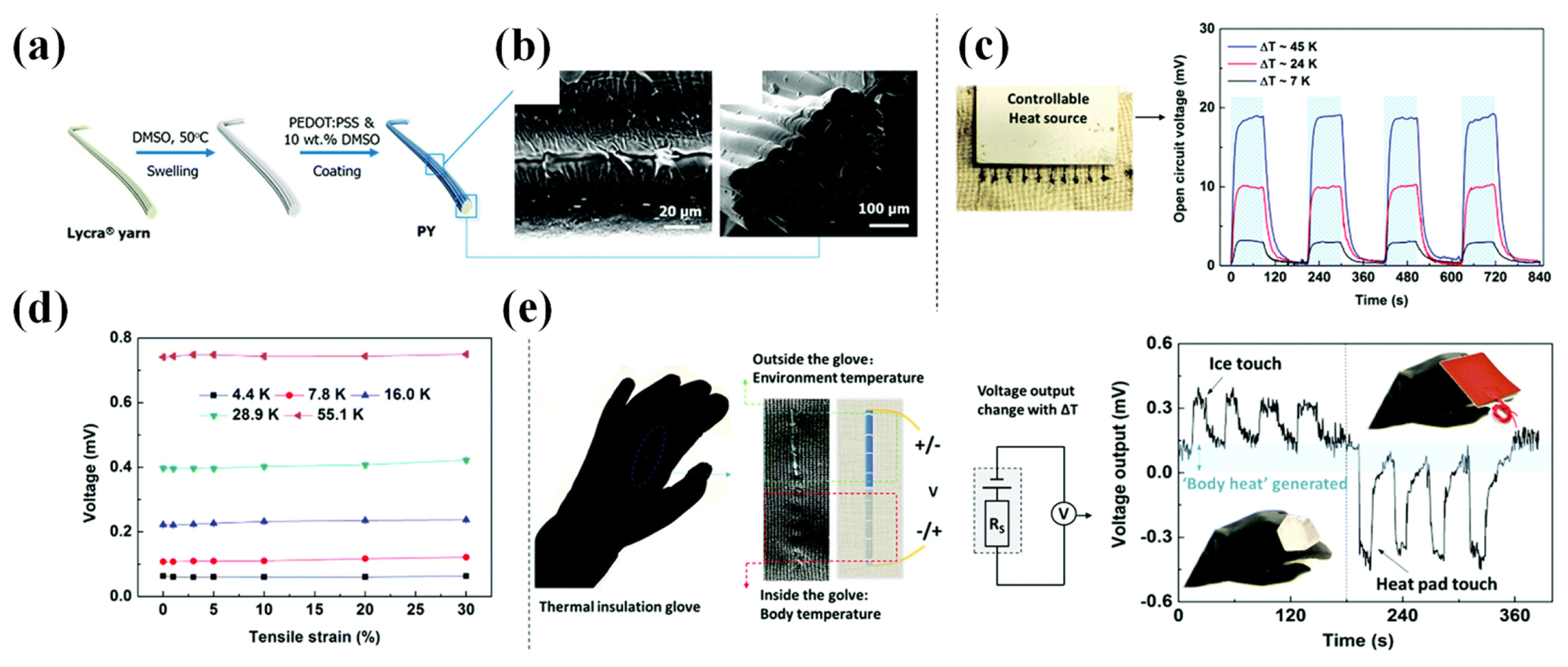

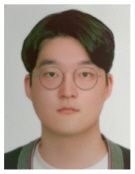

 PDF Links
PDF Links PubReader
PubReader Full text via DOI
Full text via DOI Download Citation
Download Citation  CrossRef TDM
CrossRef TDM



